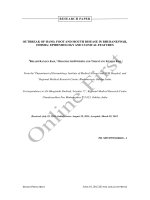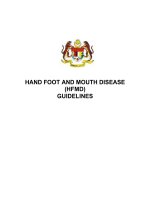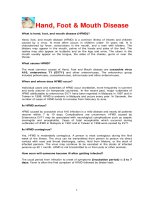Hand, Foot & Mouth Disease pot
Bạn đang xem bản rút gọn của tài liệu. Xem và tải ngay bản đầy đủ của tài liệu tại đây (249.98 KB, 9 trang )
Hand, Foot & Mouth Disease
What is hand, foot, and mouth disease (HFMD)?
Hand, foot, and mouth disease (HFMD) is a common illness of infants and children
caused by a virus. It most often occurs in children under 10 years old. It is
characterized by fever, sores/ulcers in the mouth, and a rash with blisters. The
blisters may appear in the mouth, palms of the hands and soles of the feet. The
rashes may also appear on buttocks and on the legs and arms. The ulcers in the
mouth usually appear on the tongue, the sides of the cheeks, gums or near the
throat.
What causes HFMD?
The most common causes of Hand, Foot and Mouth disease are coxsackie virus
A16, enterovirus 71 (EV71) and other enteroviruses. The enterovirus group
includes polioviruses, coxsackieviruses, echoviruses and other enteroviruses.
When and where does HFMD occur?
Individual cases and outbreaks of HFMD occur worldwide, more frequently in summer
and early autumn (in temperate countries). In the recent past, major outbreaks of
HFMD attributable to enterovirus EV71 have been reported in Malaysia in 1997 and in
Taiwan in 1998. HFMD is endemic in Malaysia and occurs every year. In Sarawak, the
number of cases of HFMD tends to increase from February to June.
Is HFMD serious?
HFMD caused by coxsackie virus A16 infection is a mild disease and nearly all patients
recover within 7 to 10 days. Complications are uncommon. HFMD caused by
Enterovirus EV71 may be associated with neurological complications such as aseptic
meningitis and encephalitis. Cases of fatal encephalitis which occurred during
outbreaks of HFMD in Malaysia in 1997 and in Taiwan in 1998 were caused by EV71.
Is HFMD contagious?
Yes, HFMD is moderately contagious. A person is most contagious during the first
week of the illness. The virus can be transmitted from person to person via direct
contact with nose and throat discharges, saliva, fluid from blisters, or the stool of
infected persons. The virus may continue to be excreted in the stools of infected
persons up till 1 month. HFMD is not transmitted to or from pets or other animals.
How soon will someone become ill after getting infected?
The usual period from infection to onset of symptoms (incubation period) is 3 to 7
days. Fever is often the first symptom of HFMD followed by blister/rash.
1
What are the clinical signs and symptoms?
HFMD begins with a mild fever, poor appetite, malaise ("feeling sick"), and frequently
a sore throat. One or 2 days after the fever begins, painful sores develop in the
mouth. They begin as small red spots that blister and then often become ulcers. They
are usually located on the tongue, gums, and inside of the cheeks. The skin rash
develops over 1 to 2 days with flat or raised red spots, some with blisters on the
palms of the hand and the soles of the feet. A person with HFMD may have only the
rash or the mouth ulcers.
Blister on the palms of the hands Blister on the soles of the feet.
Blister then become ulcer on the inner gums Blister on the dorsum of the feet
Source of pictures: http//:tray.dermatology,uiowa.edu/Coxsack01.htm
How is hand, foot and mouth disease diagnosed?
Hand, foot and mouth disease is usually diagnosed based on a complete history and
physical examination of your child. It is generally suspected on the appearance of
blister-like rash on hands, feet and mouth in children with a mild febrile illness.
Usually, the doctor can distinguish between HFMD and other causes of mouth sores
based on the age of the patient, the pattern of symptoms reported by the patient or
parent, and the appearance of the rash and sores on examination. A throat and/or
blister swab collected preferably within 2 days of onset of HFMD may be sent to a
laboratory to determine which enterovirus caused the illness.
2
How is HFMD treated?
Presently, there is no specific effective antiviral drugs and vaccine available for the
treatment of HFMD. Symptomatic treatment is given to provide relief from fever,
aches, or pain from the mouth ulcers. Dehydration is a concern because the mouth
sores may make it difficult and painful for children to eat and drink. Should their
affected children be having fever, the parents are advised to dress their children in
light, thin clothing, to do tepid sponging with water (room temperature) as often as
necessary, and to expose them under the fan. Taking enough liquids is very important
apart from body temperature monitoring.
Who is at risk for HFMD?
HFMD occurs mainly in children under 10 years old, but may also occur in adults too.
Everyone is at risk of infection, but not everyone who is infected becomes ill. Infants,
children, and adolescents are more likely to be susceptible to infection and illness
from these viruses, because they are less likely than adults to have antibodies and be
immune from previous exposures to them. Infection results in immunity to the
specific virus, but a second episode may occur following infection with a different virus
belonging to the enterovirus group.
What are the risks to pregnant women exposed to children with HFMD?
Because enteroviruses, including those causing HFMD, are very common, pregnant
women are frequently exposed to the virus as well. As for any other adults, the risk of
infection is higher for pregnant women who do not have antibodies from earlier
exposures to these viruses, and who are exposed to young children - the primary
spreaders of enteroviruses.
Most enterovirus infections during pregnancy cause mild or no illness in the mother.
Although the available information is limited, currently there is no clear evidence that
maternal enteroviral infection causes adverse outcomes of pregnancy such as
abortion, stillbirth, or congenital defects. However, mothers infected shortly before
delivery may pass the virus to the newborn. Babies born to mothers who have
symptoms of enteroviral illness around the time of delivery are more likely to be
infected. Strict adherence to generally recommended good hygienic practices by the
pregnant woman might help to decrease the risk of infection during pregnancy and
around the time of delivery.
HMFD in childcare facilities
HFMD outbreaks occurring in childcare facilities usually coincide with an increased
number of cases in the community. Additional cases may occur since the virus may be
excreted in the stools of infected person for weeks after the symptoms subsided.
There is no specific recommendation regarding the exclusion of children with HFMD
from childcare programs, schools, or other group settings. If there is an evidence of
transmission in any childcare setting (2 or more cases detected within a period
of 7 days), Sarawak Health Department will close the premise for a period of 14
days.
3
During an outbreak, everyone is advised:
• To always practise good hand washing technique and good personal hygiene,
• Thoroughly wash and disinfect contaminated items and surfaces using diluted
solution of chlorine-containing bleach (10% concentration).
• Daily examination of children for HFMD; if positive, call parents to bring child
home and don’t bring child back to childcare center till recover.
• Disinfect premises
• Proper handwashing demo to children
Can HFMD be prevented?
Specific prevention for HFMD or other non-polio enterovirus infections is not available,
but the risk of infection can be lowered by good hygienic practices. Preventive
measures include:
a. Frequent hand washing, especially after diaper changes, after using toilet
and before preparing food,
b. Maintain cleanliness of house, child care center, kindergartens or schools
and its surrounding,
c. Cleaning of contaminated surfaces and soiled items with soap and water,
and then disinfecting them with diluted solution of chlorine-containing
bleach (10% concentration),
d. Parents are advised not to bring young children to crowded public places
such as shopping centers, cinemas, swimming pools, markets or bus
stations,
e. Bring children to the nearest clinic if they show signs and symptoms.
Refrain from sending them to child care centers, kindergartens or schools.
f. Avoidance of close contact (kissing, hugging, sharing utensils, etc.) with
children having HFMD illness to reduce of the risk of infection.
HFMD In Sarawak
Hand-foot-mouth disease (HFMD) is endemic in Sarawak. Prior to 1997, there was no
baseline data on the epidemiology of HFMD in Sarawak. This is due to the fact that
HFMD is not a notifiable disease in Malaysia and in Sarawak.
Between 15 April and 30 June 1997, 31 previously healthy infants and young children
in Sarawak died after a short febrile illness against a background of an outbreak of
HFMD in the State. Sibu was badly affected during this outbreak as 11 of the death
cases were reported from Sibu followed by Sarikei with 7 death cases.
Surveillance of HFMD was initiated by Sarawak Health Department during this
outbreak of sudden deaths among young children in Sarawak from 6 June 1997. The
surveillance was stopped in December 1997. However, in 1998, following a report of
increased cases of HFMD seen in private paediatrician clinics, sentinel surveillance of
HFMD in collaboration with UNIMAS was re-started in the State involving urban public
and private clinics in Kuching, Sibu and Miri and 3 government hospitals in Sarawak.
When the enterovirus outbreak was reported in Taiwan in May 1998, the surveillance
of outpatient and inpatient HFMD was extended to all government health facilicities in
the state in June 1998.
4
Epidemiological data from the sentinel surveillance conducted by Sarawak Health
Department and UNIMAS shows a three yearly EV71 epidemic cycle and predicted the
occurrence in 2006. Hence, a reminder was sent to our division/district health offices
in 2005 to intensify surveillance for HFMD and increase health promotion and
education activities particularly at children care centers and institutions.
In 2006, the surveillance data does not depict any unusual increase in the number of
HFMD cases in the State. However, in Sibu, the cases reported by week are; week 1
(no case), week 2 (3 cases), week 3 (10 cases), week 4 (57 cases), week 5 (54
cases), week 6 (26 cases) and week 7 (24 cases). As of 2 March 2006, there are four
notified HFMD deaths in Sibu Hospital. Out of that, only 2 cases found to be positive
for EV71.
Epidemic Curve
HFMD IN SARAWAK IN 1998
0
10
20
30
40
50
60
1
4
7
10
13
16
19
22
25
28
31
34
37
40
43
46
49
52
EPID WEEK
NUMBER OF CASES
HFMD IN SARAWAK IN 2000
0
20
40
60
80
100
120
140
160
180
200
1
5
9
13
17
21
25
29
33
37
41
45
49
EPID WEEK
NUMBER OF CASES
Chart 1 : HFMD Cases in 1998 Chart 2 : HFMD Cases in 2000
HFMD IN SARAWAK IN 2003
0
50
100
150
200
250
300
350
400
1
4
7
10
13
16
19
22
25
28
31
34
37
40
43
46
49
52
EPID WEEK
NUMBER OF CASES
HFMD IN SARAWAK IN 2005
0
50
100
150
200
250
300
1
4
7
10
13
16
19
22
25
28
31
34
37
40
43
46
49
52
EPID WEEK
NUMBER OF CASES
Chart 3 : HFMD Cases in 2003 Chart 4 : HFMD Cases in 2005
5
Areas affected by HFMD.
HFMD is endemic in Sarawak with yearly occurrence. Kuching, Sibu, Miri and Bintulu
have been noted to be “hotspots” for HFMD.
Age Group Affected by HFMD In Sarawak.
HFMD mainly affect children of below 10 years old. Deaths associated with HFMD
mostly occur among children below 6 years old.
What Sarawak Health Department Have Done?
The activities carried out by the department are:
Reduction of Transmission
Initially every department are advised voluntary closure by the operators of
child care centers and kindergartens as well as advise them to carry out
cleaning, disinfection of their premises, furniture, equipment, toys etc. As of
24 February 2006 issue closure orders to operators of childcare centers,
kindergartens and primary schools it they found to have 2 or more cases
within 7 days. On 3 March 2006, Ministry of Health Malaysia announce
directive for statewide closure for childcare centers (TASKA, TADIKA, TABIKA
etc) or similar premises for 2 week with immediate effect.
Advise child care centre operators to do daily inspection of hands, feet and
mouth of their enrolled children for rashes and ulcers
Advise parents with affected children to bring them to see a doctor
immediately
Issuance of instruction to all Divisional Health Officers to conduct HFMD
briefing to all medical practitioners in the public and private sectors on or
before 6 March 2006, with emphasize on the importance of immediate
notification, early referral and criteria for admission of potentially severe HFMD
so as to minimize the scale and duration of the current HFMD outbreak.
Mobilisation and deployment of all public health staff within the state (intra
and inter division) to conduct field investigation of all reported HFMD cases. To
seek assistance from other states/MOH if necessary for additional health staff.
Screening clinics- all public and private health care practitioners are advised to
notify all cases of HFMD seen to their respective Divisional Operations Room
daily. They are also advised to segregate these patients from the general out-
patient waiting area and wherever possible, to attend to these cases
immediately.
Health Education Activities
Supply HFMD health education pamphlets for distribution by the operators of
the child care centers/kindergartens to every parent of their enrolled children
6
Carry out radio talks in Bahasa Melayu, English, Mandarin, Iban and Bidayuh
through RTM for state-wide broadcast on HFMD
Print and disseminate health education pamphlets in 4 languages (English,
Bahasa Melayu, Mandarin, Iban)
Enforcement of Legislation
Statewide closure of all childcare centers/kindergartens was announced by the
Minister of Health Malaysia on 3
rd
March 2006.
Delegation of authority by the State Health Director, Sarawak to the Divisional
Health Officers to close tadika/taska and kindergartens using Section 7(2) of
the Protection of the Public Health Ordinance 1999 Sarawak.
Interagency Assistance
Mobilisation of health teams at district and divisional level to conduct sanitary
inspection, physical examination of all enrolled children at all registered child
care centers as per list of child care centers furnished by the relevant agencies
Request for the assistance and co-operation of Hornbill Skyways to assign a
standby helicopter in Kuching, Sibu and Miri to facilitate immediate medical
evacuation of ill children with HFMD to any of the three designated hospitals
(SGH, Kuching, Sibu and Miri)
Should the number of cases continue to increase in the State, to recommend
to the Education Department for the immediate closure of all primary schools
for 14 days
Management Protocols
Observation and isolation facilities –instructions have been issued to all
government hospitals to set up special isolation wards/cubicles to
accommodate all admitted HFMD cases including referrals by private or health
clinics.
Distribute the revised HFMD management protocols/guidelines to all
practitioners throughout the state (Kuching Division done on 28 Feb. 2006)
Remind all hospital staff especially those working in the isolation
wards/cubicles and out-patient clinics to observe strict universal precautions
Is Sarawak Safe To Visit?
Sarawak is still very safe to visit. The HFMD situation is very much under control.
Nevertheless, visitors who bring along their young children to Sarawak are advised to
take extra precautionary measures and to practise good personal hygiene at all time s
especially good hand washing technique.
7
Case Notifications
Anybody can notify the Sarawak Health Department about any case detected via
phone call, fax or e-mail or report direct to the nearest Health Center within the
community. Notification Form can be downloaded in PDF format as attached.
Notification Form
Further Inquiries on HFMD Information In Sarawak:
Hotline : 60 82 246350
Fax : 60 82 247254
E-mail:
8
OPERATION ROOM CONTACT NUMBER FOR HFMD IN SARAWAK 2006
NO.
DIVISION/
DISTRICT
TEL. NUMBER FAX NUMBER
1 KUCHING +60 82 250037 +60 82 414542
2 BAU +60 82 763116 +60 82 762381
3 LUNDU +60 82 735311 +60 82 734652
4 SAMARAHAN +60 82 673626 +60 82 673632
5 SERIAN +60 82 874311 +60 82 876811
6 SIMUNJAN +60 82 803612 +60 82 803823
7 SRI AMAN +60 83 322176 +60 83 323220
8 LUBOK ANTU +60 83 584105 +60 83 584080
9 BETONG +60 83 472116 +60 83 471870
10 SARATOK +60 83 437379 +60 83 437886
11 SARIKEI +60 84 651077 +60 84 658598
12 JULAU +60 84 734067 +60 84 734253
13 PAKAN +60 84 717225 +60 84 717225
14 MERADONG +60 84 693333 +60 84 693494
15 SIBU +60 84 345862 +60 84 348284
16 KANOWIT +60 84 752333 +60 84 752682
17 MUKAH +60 84 873201 +60 84 872459
18 DALAT +60 84 863087 +60 84 864269
19 MATU +60 84 832236 +60 84 832236
20 DARO +60 84 823744 +60 84 823886
21 KAPIT +60 84 796471 +60 84 796454
22 SONG +60 84 777634 +60 84 777514
23 BELAGA +60 86 461545 +60 86 461508
24 BINTULU +60 86 315235 +60 86 339094
25 TATAU +60 86 584619 +60 86 584619
26 MIRI +60 85 824260 +60 85 424235
27 MARUDI +60 85 755511 +60 85 755217
28 LIMBANG +60 85 211046 +60 85 214652
29 LAWAS +60 85 283781 +60 85 284807
9









